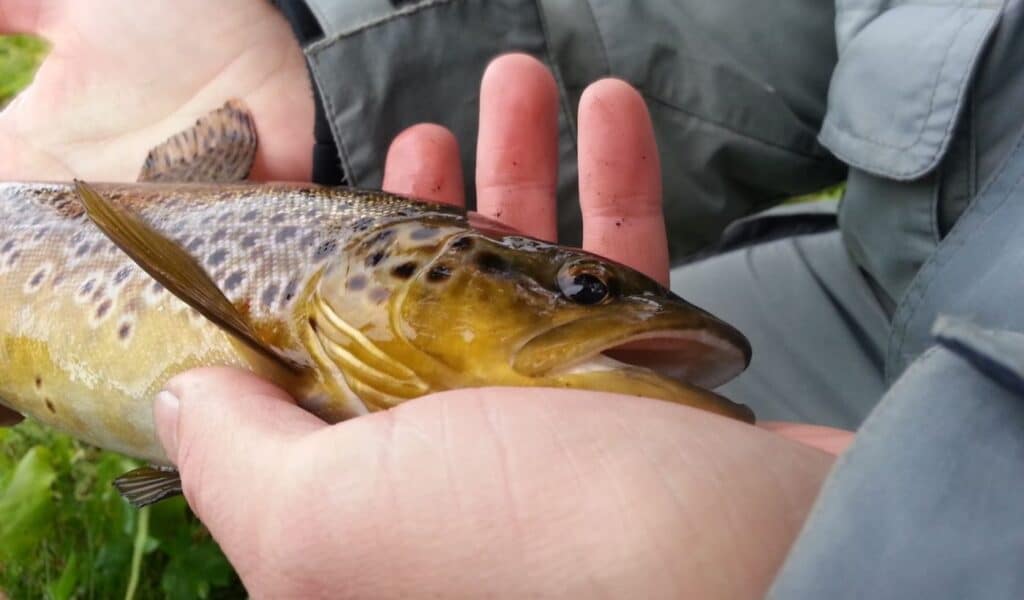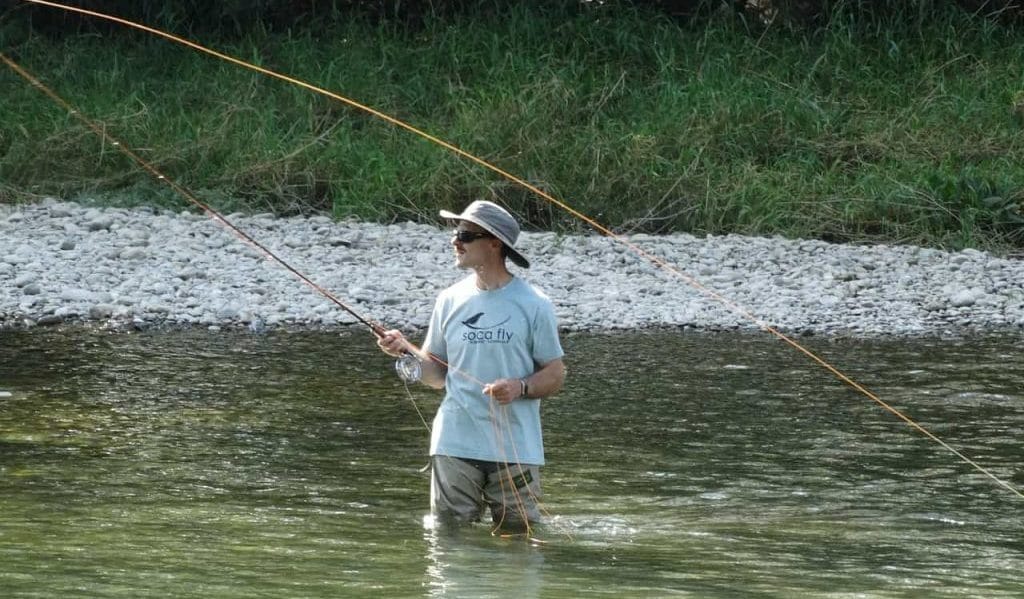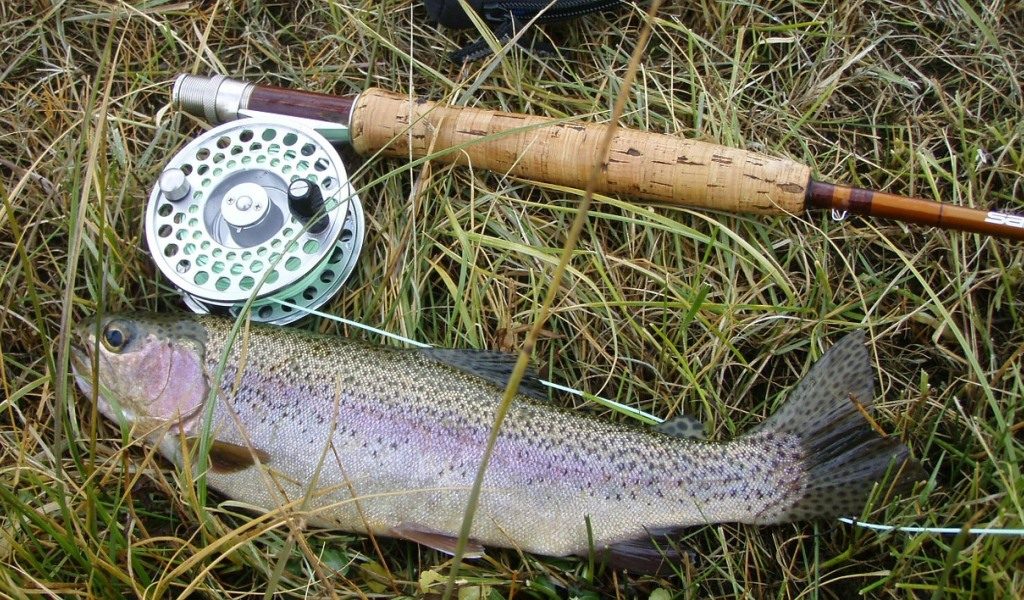Ask any angler in the world and you’ll find that only a few things compare to the enthusiasm of catching trout. But, it is popularly believed that you can’t go trout fishing without a fly rod. Some fishermen even consider it impossible to catch trout using a spinning rod.
But, there are many techniques for catching trout without a fly rod. Like any other fish, some things attract trout, certain places it likes, and some tricks that always work. So, we have shared our proven tips and tricks to help you catch a trout without fly fishing gear.
15 Tips & Tricks for Trout Fishing without a Fly Rod
Fly fishing for trout promises a thrilling experience and satisfaction at the end of the day. So, for many fly anglers, a break is when they head to the nearest stream, river, or lake to look out for trout.
But some anglers prefer not to fly fish or know how to fly fish. Some anglers prefer spin fishing and don’t wish to buy a fly rod for trout fishing.
If you fall into one of these categories, we’ve got you covered. After all, the trout don’t know you aren’t using a fly rod. If you are looking for an affordable fly rod, you can check our pick of the Best Fly Rods Under $200.
All you need to know is what will make the fish gravitate towards you. You can successfully fish for trout if you observe and follow its natural tendencies.
1. Look for a Seam of White Foam
Wild trout love to target white foam for food. All you need to do is toss your bait into a line of white foam. Take care to be as accurate as possible. You must take this shot exactly at the seam of white foam, otherwise, they’ll know.
Don’t get disheartened if you don’t get it right the first time. Almost nobody does. This will need some practice. But the key to catching trout is accuracy and caution. You cannot drop your bait below the foam line as the fish will detect any disturbance in clear water and scatter away.
2. Find a Big Rock in the Stream
Try to find big rocks or objects in the current of water as there is always a pool of calm water upstream from the rock. Abundant trout can be found here. This is a proven trick we have often used for catching trout without fly fishing equipment.
Just throw your bait upstream from the pool in such a way that the flow of water guides it down towards the pool. The trout will be immediately attracted to this setup if it looks natural enough.
But don’t set your hook strong as it could snatch the bait right out of the fish’s mouth and you’ll miss a great catch.
3. Try Using the Dead Stick Technique
Dead Stick is one of the classic trout fishing techniques in which you flow soft plastic bait along with the current of water.
This technique is most successful in streams with a gentle current. All you need to do is, drop your bait on the top of the stream and let it flow.
You can use this technique with a fly as well. It’s just that the attraction apparatus remains on the surface of the water. This allows you to easily catch the fish as soon as it hits the bait.
4. Aim at the Bank
A favorite hangout spot for trout, the bank covers more area in smaller streams than you realize. If you notice a dark abyss near the shore of a stream, you have found the place where most trout hide.
But you must target this area carefully. Hang your fly on top of the water so it is just right above the stream. If you are using a jig, you can drop it down and see if it incites some fish into action.
Sometime you will return empty-handed. But most days you’ll take home the large trout you have been targeting.
5. Use the Bead Head Prince Nymph

If you’ve ever gone trout fishing, you’d know the trout are big fans of the bead head prince nymph. This small-sized fly floats just below the water’s surface due to its beaded head that lets it sink smoothly.
And guess what? You don’t need a fly rod to use the bead head prince nymph! You can use it with a bobber to make a very efficient setup for getting trout. You can set the bobber about six feet apart from where you tie the nymph. It will allow you to move the fly up and down to set the depth.
Trout love this setup and always fall for it unless they know it’s a trap, which they sometimes will.
6. Try Corn on a Hook Trick
When you’re aiming for trout with a jig, use the classing technique of crowning the hook with a piece of corn. Not only will the hook look nice, but it will also attract more trout.
Corn has always been successfully used to get trout. The older trout will probably recognize your trick. But many younglings won’t.
In case you don’t have a lure or a jig on you, just hang the corn using the dead stick technique where there are trout. This trick may sound simple for a fish like a trout, but it is proven to work.
7. Put Your Smallest Silver Spoons into Action

Most trout are not more than 16 inches in size. So you’ll need the smallest size bait for their small mouths. Trout go for live baits that are easy to catch.
You shouldn’t worry about the visibility of the small-size bait. Trout have very keen eyes and they see everything.
Small size silver spoons are very effective if you want to catch trout. They have been tried and tested for generations. So, try to get the smallest spoons possible.
8. Use Smaller Hooks
A big-sized hook will lower your chances of landing a fish while a smaller hook will be the more effective. Trout have small mouths as mentioned earlier, so it is easier to get tiny hooks in their mouth.
Even fish can recognize that the big hook could be dangerous for them. Besides, you don’t find big trout in small streams. So, you’d rather aim for the ones that are available.
9. Use a Lightweight Rod and Reel Setup
Smaller fish are best caught with lightweight rod and reel setups. So, pick up an ultralight trout rod with fast or medium-fast action and pair it with a 1500 or 2000-size fishing reel spooled with a light line.
You can catch small fish species such as trout better using relatively light fishing gear. But any setup can work if you are dedicated and patient enough.
10. Try Finding Dark Places
It would be right to say trout love dark and cool places. So you should always look for shade along the shore and deep holes along the bank of a stream.
Both these spots have enough shade to invite trout. You’d be lucky if you find a spot that is deep, along the shore, and in the shade. There must be a trout party at the place.
It is also important to look for deep pools of water. Trout are cold-blooded and tend to seek cool areas. Deeper pools will be the coolest areas for trout to live in. Their metabolism slows down in cold water, but they will still be hungry in the summer months.
11. Avoid Casting Your Own Shadow
While looking for shade along the shore, make sure you yourself don’t cast a shadow. Always approach the spot carefully, without casting any shadows. Make sure you duck down gently.
Trout can sense danger when a shadow is cast and disperse immediately. And once you poke a set of fish this way, all the surrounding fishes will tend to disperse as well.
12. Never Set Your Hook Too Hard
While it is important to set up an effective bait, you must be careful while setting the hook. Anglers often snatch the bait right out of the fish’s mouth when they use powerful fishing rods.
Remember you can catch a fish only when you follow its natural tendencies. Trout don’t swallow the entire bait like bass. They tend to nibble at the bait and then decide if they should swallow.
So, your hook set must be short and quick. Don’t keep waiting after the trout has swallowed your bait. You might miss more fish than you’d catch if you don’t pay attention.
13. Try Using Marshmallows as Bait
Fishing is about tricking the fish especially where they don’t respond to usual baits. Fish will respond to attractive food they haven’t seen before. Sometimes fish immediately gulp it down.
An added advantage of marshmallows is that they don’t pull apart easily. A marshmallow stays together and doesn’t come out of your hook easily.
14. Use Worms, Classic Trout Bait
Most trout will tend to gravitate towards food that they usually eat. All fish don’t look for fancy meals, some do settle for usual diets. Worms have been forever used for catching trout and it is no wonder they work.
The big trout is more likely to go after worms. This is the reason why these tiny creatures are often given jobs on vast lakes and rivers where you can find big trout.
15. Make Careful and Delicate Presentations
As soon as you spot a fish, don’t just put your fishing line in without a second thought. This is the time when you make your most well-calculated move.
You should always drop your fly line beyond the fish, not on top of them. The fish may get spooked and scatter if you drop it right above their heads.
When the water in the stream is moving fast, maintain even more caution as the fish may be looking upstream.
Final Thoughts
Your fishing experience is meant to be enjoyable, so you must never get impatient. Trout can be one of the most difficult fish to catch. But, one must keep trying until one lands a laudable catch. A method that works for someone may not work for others. This is also true for different places and different size trout. But, keeping our tips and tricks in mind will help you land your target fish.
So, follow our tips the next time you’re out trout fishing without a fly rod. Just remember no matter how careful or patient you are, you’ll catch a fish only when it is willing to bite.
Last Updated on May 15, 2025 by Blaine Townsend




